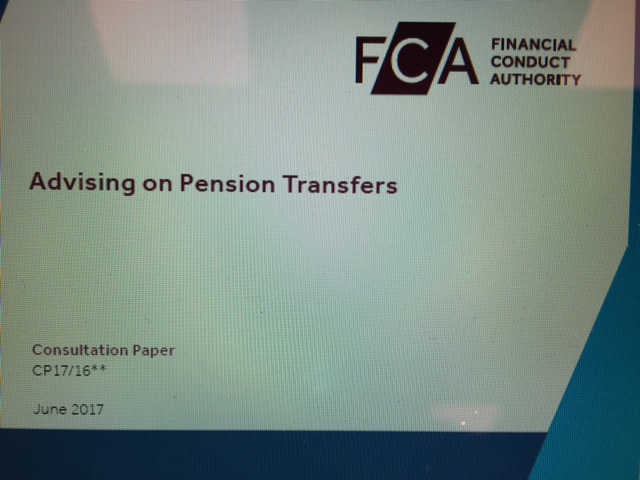
Today’s FCA proposals for new requirements for advice on Defined Benefit (DB) pension transfers are of much wider significance than that. It’s as if the regulator was comfortable bumbling along with a general approach to investment projections and suitability assessment that was just about good enough until confronted by a particular case where it was conspicuously useless. DB transfers are the case in point.
The trigger for this consultation was the recognition that the prescribed analysis required when advising on transfers was designed very narrowly on the assumption an annuity would be purchased at retirement. Pension Freedoms made it impossible for the FCA to avoid overhauling this approach – though it has still taken over two years for proposals to surface.
Forced to make more realistic and relevant prescriptions, it has had to recognise that a transfer substitutes one of what may be a number of cash flows contributing to retirement spending. It is therefore drawn logically into proposing that the advice will normally have to be holistic.
If it is fundamentally not different from other advice involving retirement cash flows, it logically has to be subject to the same general rules governing a personal recommendation of a designated investment. It is not some separate exercise of an actuarial rather than planning nature. Ironically, it is possible that making transfers a special case handled by experts, often different from the advisers doing the planning or the managing of the assets, has left this area more vulnerable, not less so, to exploitative motives than advice generally.
Though the new advice format does not have to assume that drawdown is the only means of turning capital into income, it has to treat is as one of the options. Drawdown from a transfer is, however, only a special case of a common investment goal. In fact, almost all personal goals involve consumption, including spending income. The FCA has acknowledged this only to the extent it recognises that the outcomes of a drawdown plan are not the same as the buy-and-hold outcomes implied by its prescribed growth rates for investment products. It makes a passing reference to ‘life styling’ features but without acknowledging the massive implications for comparing customised drawdown portfolios and open-ended investment products.
Finally, it has been forced to acknowledge again a problem it kicked into the long grass nearly 20 years ago. The problem of estimating uncertain outcomes (rather than just rates or return), where uncertainty is a complex interaction of multiple risk sources and time and is different for volatility than real outcomes, is a problem best addressed by stochastic modelling. How then should the FCA prescribe how these complex and arguably more complete models are reconciled (if at all) to the simplistic and incomplete deterministic projections required for the investment solution offered as a substitute for the transfer? Will forcing them to be compatible prevent really useful improvements in the accuracy and communication of risk estimates? Is it in fact the deterministic projections that need to give way?
Fowler Drew is a firm that uses stochastic models; it only manages money after performing holistic financial advice; it only manages money based on specific defined goals, including cash flow goals; makes risk tolerance not an input to but an output of planning by letting clients think about the consequences of stochastic distributions of possible outcomes; it is well used to reconciling to deterministic projections by factual descriptions of their relative merits and uses. Though not as active in transfers as many firms, drawdown is the single largest client goal and a DB transfer is only a special case of a permanent feature of drawdown that cash-flow liabilities can always be met either by a risk free hedge or an uncertain bet. Each is substitutable by the other, or can be remixed, every day. I therefore read this consultation and feel the FCA has finally arrived where we did, by the same logic.
In terms of the competitive landscape we operate in, the proposals are probably grist to our mill. This is what our transfer business already looks like. But I doubt many others do. There is no area of transfer business we exclude that this consultation will make a safer harbour. The requirement to make the benefit comparison specific to the replacement investments, though logically faultless, rules out advising self-directed investors. The same principle when applied to transfers to QROPS in conjunction (as foreseen by the DWP) with a foreign local adviser means there is far too much overlap between the two firms to make advice safe. Outsourced transfer advice is also arguably incompatible with the holistic reach of the proposals. These are all genuine advice needs some firms are meeting today that are riskier in the light of these proposals.
If everyone advising on transfers now has to be as technically proficient and broad reach as us, improving the quality and scope of transfer advice is likely to make it harder to get advice and in some areas it may effectively become impossible. This is perhaps the most important question the consultation asks. The FCA knows it has been judged harshly on such trade offs before, even when it had the full force of theory and logic on its side.
The DB transfer boom is a joint product of experimental monetary policies and DB schemes having derisked. The two are not of course entirely independent as QE has tended to increase the move to fixed income investments to back pension pensions. It will pass when real risk free rates return to more normal positive values. Transfers will not then in most cases increase individual utility and transfer volumes will fall away. But even after that, the issues raised by opening Pandora’s Box to reveal the inadequacies of both common practice and regulation in the area of modelling, planning and communicating outcomes for investment goals, particularly drawdown, will remain.